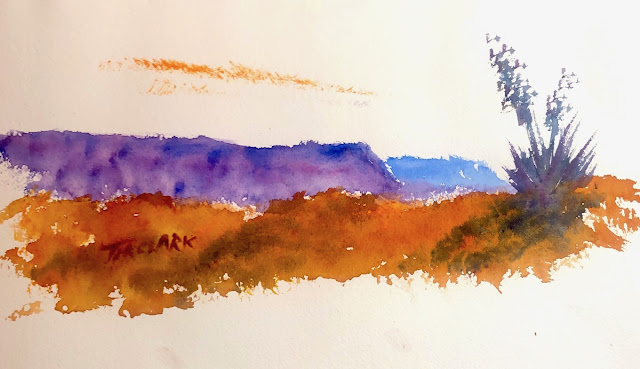 |
| "Eastern Oklahoma Dawn," 5 x 7 watercolor, 140 lb. cold press paper |
Why do I enjoy painting watercolors of barns?
Erle Thweatt Clark locked the doors, and picked up his paint brushes.
 |
| My Dad's portrait of my Grandfather |
Have you ever painted buildings—not pictures--for a living? I have, but never thought too much about where that came from. Could be genetic, when I consider my family background.
The first summer I taught high school, two other teachers and I formed a painting crew in northwest Iowa, amid rolling hills covered with soybeans and corn, where farming is serious business. Because of the severe weather, and their European ethnic backgrounds, and their pride in their way of life, farmers on those prairies keep their barns, hog houses, sheds, and houses painted on a regular basis. Rare is the farm building that's not given a new paint job every four years.
That's what we did--renting scaffolding we transported in an old pickup truck. We were contract painters and kept busy all summer, going from one farm to the next.
We were good and we were fast. We would set the scaffolding up on one side of the two- and three-story farm houses early in the morning. We’d race the sun around, starting on the east and ending up on the north late in the day. We'd start at the top, with our tool boxes, paint and brushes, and come down the side of the house before moving to the next side.
We carried scrapers, hammers, nails, caulking guns, and we started under the eaves.
Worst part were the wasps that you had to fight off every day. As a joke, one friend stuck a straw in my ear and yelled "Wasp!"
My reaction was immediate, and I jerked my arm around with my paintbrush full of white paint. It slapped him across the face, and almost knocked him off the scaffolding two stories above the ground. He didn't do that again.
Painting the towering barns and the hog houses were the biggest ordeals.
For the barns, you’d have to haul a ladder to the top scaffold, precariously perch it there, climb and stretch way up to get to the overhanging peak with your paint brush, several stories above ground, on guard for wasps..
For the hog houses, we’d put the scaffolding up beside the building, but it usually had pig manure stacked up against the foundation, and the feet of the scaffolding would sink into the muck. The smell was awful. It attacked you and clung to your hair and skin. When you got home in the evening, you'd have to strip outside on the porch rather than take the smell in the house.
 |
| Granddad and Dad's graves, Comanche, OK |
So what has all that got to do with Erle Thweatt Clark?
I learned much on one of my visits with the last Clark years ago--my uncle, the late Uncle Mike, in Santa Fe. My Dad was his oldest brother, and he’d tell stories about the Clarks I’d never heard.
I also learned the value of The Depression. The Clarks were the poorest of the poor in Comanche, Oklahoma. Five boys came out of that home, and rather than staying in the red-clay town--Terrence, Lewis, Rex, Mike, and Champ all escaped to various successful careers around the world. I never understood how some people would take such abject poverty and survive, rather than being trapped there for the rest of their lives.
Mike said they had no place to go but up, and that to get up, they all fled Comanche.
That's when he told about Erle T.--my grandfather--locking the doors and picking up his paintbrushes.
He owned a grocery store when The Depression hit, and soon his customers couldn't pay their bills. Finally giving up, Erle told everybody to come in and clean out the shelves--giving the food away to the hungry. Then he locked the door, and picked up his paints--going back to his original trade as a house painter.
All my life, I heard about the Clark boys--Terrence, Lewis, Rex, Mike, and Champ--coming home to help Grandma, Cuba Jon Miller Reasor, paint her house in Whitesboro, Texas.
Through the years, I've done my share too, even beyond those wasp-ridden, precarious barns and gagging hog houses.
Mike said a preacher told him once that in order to understand something, you had to get down and look up at the underside. He figured being the poorest people in a poor town put him underneath, looking up.
That helped prepare him for successes, based on a compassion and understanding of humans in need. That, and house painting--which must be genetic.
Maybe that’s why barns fascinate me. Now I settle for painting watercolors of them, though. Even my business card has one on it, and I've painted special ones for family members and friends.
(This has been revised from a newspaper column I wrote more than 20 years ago.)







































